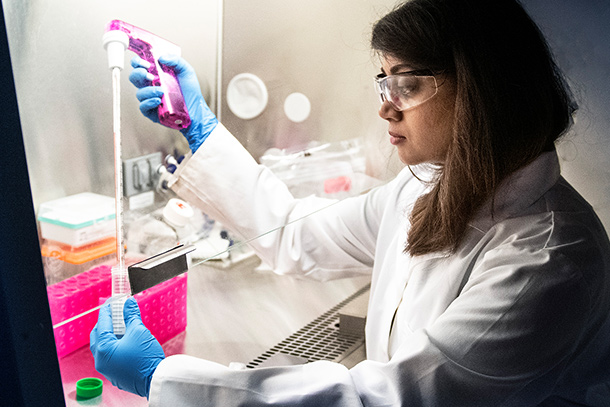
Nivetha Gunaseelan has been awarded a predoctoral fellowship from the American Heart Association to conduct research that could impact how physicians treat brain injuries. Credit: Provided by Dipanjan Pan/Penn State
Biomedical engineering grad student earns American Heart Association fellowship
Mar 31, 2025
By Ty Tkacik
UNIVERSITY PARK, Pa. — The American Heart Association (AHA) awarded Nivetha Gunaseelan, a doctoral candidate studying biomedical engineering in the Penn State College of Engineering, a predoctoral fellowship. The opportunity provides Gunaseelan over $60,000 to continue her research on molecular imaging of brain injuries with her faculty adviser, Dipanjan Pan, the Dorothy Foehr Huck & J. Lloyd Huck Chair Professor in Nanomedicine, professor of nuclear engineering and of materials science and engineering.
“Grants from the American Heart Association have been a strong part of my lab's history,” Pan said. “It is exciting to see that Nivetha joins several former members of the Pan Lab who have previously received this award. In the time that I’ve been able to work with her, Nivetha has established herself as an incredibly skilled researcher and student. I’m excited to see how her research grows, especially now with the fellowship’s additional support.”
The AHA Predoctoral Fellowship supports the research and clinical training of promising graduate students who intend to pursue careers aimed at improving global cardiovascular, cerebrovascular and brain health, according to AHA. Recipients are provided two years of financial support to pursue and improve their research, which includes a stipend, health insurance and travel support.
“Receiving this prestigious national award from the AHA is extremely gratifying, as it validates the significance of my research and the passion I bring to advancing diagnostic imaging,” Gunaseelan said. “This is a tremendous honor, and I believe that with the fellowship’s support, we will make significant strides forward in our work.”
Brain injuries are a major contributor to cerebrovascular diseases, and one of the top causes for injury related deaths and disabilities each year, Gunaseelan explained. Early detection and staging of an injury is important to provide accurate care, but conventional CT scans with black-and-white imaging have issues quantifying the severity of an injury.
In her application for the fellowship, Gunaseelan displayed her new technique to test brain injuries. The approach introduces an imaging technique, known as spectral photon-counting CT, that uses specific nanoparticles to identify biomarkers — molecules, proteins or other biological factors that can be measured in the body — released in the brain after injuries.
“This technology will help us visualize the extent of the brain injury in ‘color’ by using a contrast agent targeted to a biomarker overexpressed in the brain following an injury,” Gunaseelan said.
Credit: Penn State University
The work could allow physicians to take what Gunaseelan calls a two-step targeting approach: The contrast agent made of tiny nanoparticles could first target the central nervous system and cross the blood brain barrier, then target specific tissues that appear to be damaged by detecting an overexpression of a biomarker that traditionally follows a brain injury.
“Our goal is to revolutionize brain injury diagnosis by presenting the separate layers of soft tissue, fat tissue and bone in addition to this biomarker binding contrast agent as high-resolution, colored images,” Gunaseelan said. “Providing physicians ways to address these injuries faster is the key to improving treatment.”
In future studies, Gunaseelan plans to explore the potential of photon-counting CT for image-guided drug delivery.
“The proper application of this technology with the right nanoparticle contrast agents could have a big impact on how doctors and physicians combat chronic illnesses such as cancer and heart disease,” Gunaseelan said.
Gunaseelan earned her bachelor’s degree in electronics and communication engineering from the Birla Institute of Technology and Science, India, and her master’s degree in biomedical engineering from the University of Illinois Urbana-Champaign. Prior to continuing her education at Penn State, Gunaseelan worked as a research and design engineer at InnSight Technology and a research fellow at the University of Maryland.
As a member of the Pan Lab, Gunaseelan served as first author on an Advanced Science paper published in December 2024 that applied spectral photon-counting CT to biomedical uses. The lab’s current work is supported through a Congressional Directed Medical Research Program grant from the U.S. Department of Defense.

